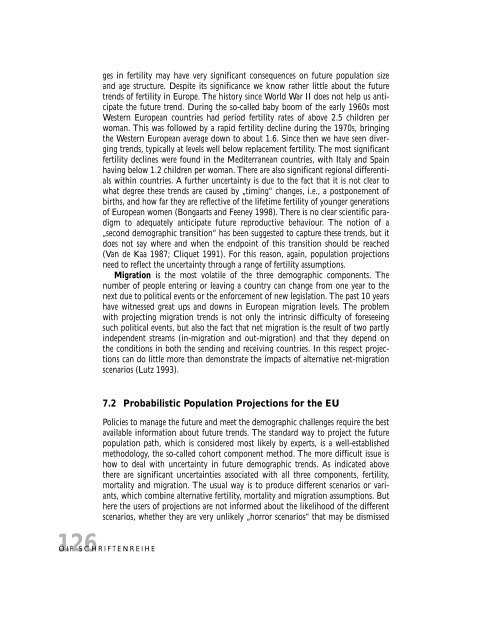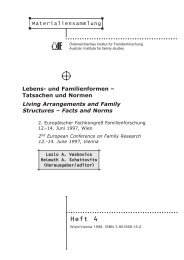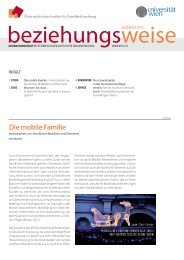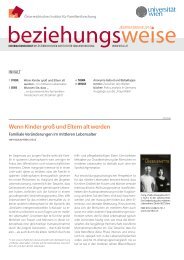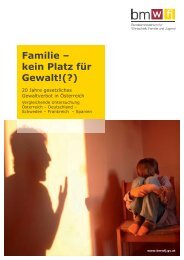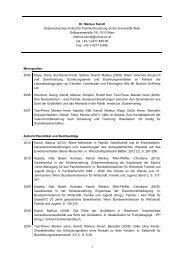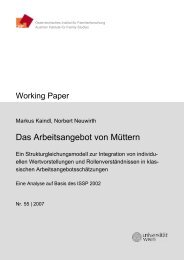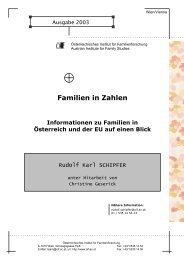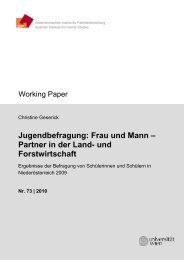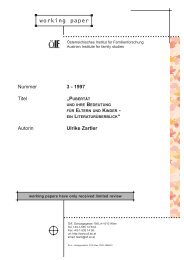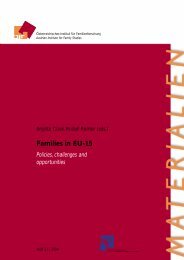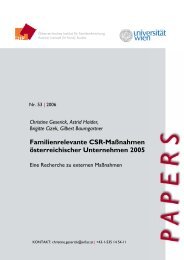Kompendium der Familienforschung in Ãsterreich, Schriftenreihe Nr. 7
Kompendium der Familienforschung in Ãsterreich, Schriftenreihe Nr. 7
Kompendium der Familienforschung in Ãsterreich, Schriftenreihe Nr. 7
Erfolgreiche ePaper selbst erstellen
Machen Sie aus Ihren PDF Publikationen ein blätterbares Flipbook mit unserer einzigartigen Google optimierten e-Paper Software.
ges <strong>in</strong> fertility may have very significant consequences on future population size<br />
and age structure. Despite its significance we know rather little about the future<br />
trends of fertility <strong>in</strong> Europe. The history s<strong>in</strong>ce World War II does not help us anticipate<br />
the future trend. Dur<strong>in</strong>g the so-called baby boom of the early 1960s most<br />
Western European countries had period fertility rates of above 2.5 children per<br />
woman. This was followed by a rapid fertility decl<strong>in</strong>e dur<strong>in</strong>g the 1970s, br<strong>in</strong>g<strong>in</strong>g<br />
the Western European average down to about 1.6. S<strong>in</strong>ce then we have seen diverg<strong>in</strong>g<br />
trends, typically at levels well below replacement fertility. The most significant<br />
fertility decl<strong>in</strong>es were found <strong>in</strong> the Mediterranean countries, with Italy and Spa<strong>in</strong><br />
hav<strong>in</strong>g below 1.2 children per woman. There are also significant regional differentials<br />
with<strong>in</strong> countries. A further uncerta<strong>in</strong>ty is due to the fact that it is not clear to<br />
what degree these trends are caused by „tim<strong>in</strong>g“ changes, i.e., a postponement of<br />
births, and how far they are reflective of the lifetime fertility of younger generations<br />
of European women (Bongaarts and Feeney 1998). There is no clear scientific paradigm<br />
to adequately anticipate future reproductive behaviour. The notion of a<br />
„second demographic transition“ has been suggested to capture these trends, but it<br />
does not say where and when the endpo<strong>in</strong>t of this transition should be reached<br />
(Van de Kaa 1987; Cliquet 1991). For this reason, aga<strong>in</strong>, population projections<br />
need to reflect the uncerta<strong>in</strong>ty through a range of fertility assumptions.<br />
Migration is the most volatile of the three demographic components. The<br />
number of people enter<strong>in</strong>g or leav<strong>in</strong>g a country can change from one year to the<br />
next due to political events or the enforcement of new legislation. The past 10 years<br />
have witnessed great ups and downs <strong>in</strong> European migration levels. The problem<br />
with project<strong>in</strong>g migration trends is not only the <strong>in</strong>tr<strong>in</strong>sic difficulty of foresee<strong>in</strong>g<br />
such political events, but also the fact that net migration is the result of two partly<br />
<strong>in</strong>dependent streams (<strong>in</strong>-migration and out-migration) and that they depend on<br />
the conditions <strong>in</strong> both the send<strong>in</strong>g and receiv<strong>in</strong>g countries. In this respect projections<br />
can do little more than demonstrate the impacts of alternative net-migration<br />
scenarios (Lutz 1993).<br />
126<br />
7.2 Probabilistic Population Projections for the EU<br />
Policies to manage the future and meet the demographic challenges require the best<br />
available <strong>in</strong>formation about future trends. The standard way to project the future<br />
population path, which is consi<strong>der</strong>ed most likely by experts, is a well-established<br />
methodology, the so-called cohort component method. The more difficult issue is<br />
how to deal with uncerta<strong>in</strong>ty <strong>in</strong> future demographic trends. As <strong>in</strong>dicated above<br />
there are significant uncerta<strong>in</strong>ties associated with all three components, fertility,<br />
mortality and migration. The usual way is to produce different scenarios or variants,<br />
which comb<strong>in</strong>e alternative fertility, mortality and migration assumptions. But<br />
here the users of projections are not <strong>in</strong>formed about the likelihood of the different<br />
scenarios, whether they are very unlikely „horror scenarios“ that may be dismissed<br />
ÖIF SCHRIFTENREIHE


